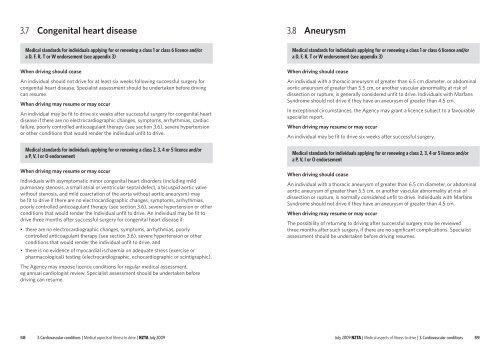Medical aspects of fitness to drive a guide for medical practitioners
Medical aspects of fitness to drive a guide for medical practitioners
Medical aspects of fitness to drive a guide for medical practitioners
You also want an ePaper? Increase the reach of your titles
YUMPU automatically turns print PDFs into web optimized ePapers that Google loves.
3.7<br />
Congenital heart disease<br />
3.8<br />
Aneurysm<br />
<strong>Medical</strong> standards <strong>for</strong> individuals applying <strong>for</strong> or renewing a class 1 or class 6 licence and/or<br />
a D, F, R, T or W endorsement (see appendix 3)<br />
When driving should cease<br />
An individual should not <strong>drive</strong> <strong>for</strong> at least six weeks following successful surgery <strong>for</strong><br />
congenital heart disease. Specialist assessment should be undertaken be<strong>for</strong>e driving<br />
can resume.<br />
When driving may resume or may occur<br />
An individual may be fit <strong>to</strong> <strong>drive</strong> six weeks after successful surgery <strong>for</strong> congenital heart<br />
disease if there are no electrocardiographic changes, symp<strong>to</strong>ms, arrhythmias, cardiac<br />
failure, poorly controlled anticoagulant therapy (see section 3.6), severe hypertension<br />
or other conditions that would render the individual unfit <strong>to</strong> <strong>drive</strong>.<br />
<strong>Medical</strong> standards <strong>for</strong> individuals applying <strong>for</strong> or renewing a class 2, 3, 4 or 5 licence and/or<br />
a P, V, I or O endorsement<br />
When driving may resume or may occur<br />
Individuals with asymp<strong>to</strong>matic minor congenital heart disorders (including mild<br />
pulmonary stenosis, a small atrial or ventricular septal defect, a bicuspid aortic valve<br />
without stenosis, and mild coarctation <strong>of</strong> the aorta without aortic aneurysm) may<br />
be fit <strong>to</strong> <strong>drive</strong> if there are no electrocardiographic changes, symp<strong>to</strong>ms, arrhythmias,<br />
poorly controlled anticoagulant therapy (see section 3.6), severe hypertension or other<br />
conditions that would render the individual unfit <strong>to</strong> <strong>drive</strong>. An individual may be fit <strong>to</strong><br />
<strong>drive</strong> three months after successful surgery <strong>for</strong> congenital heart disease if:<br />
• there are no electrocardiographic changes, symp<strong>to</strong>ms, arrhythmias, poorly<br />
controlled anticoagulant therapy (see section 3.6), severe hypertension or other<br />
conditions that would render the individual unfit <strong>to</strong> <strong>drive</strong>, and<br />
• there is no evidence <strong>of</strong> myocardial ischaemia on adequate stress (exercise or<br />
pharmacological) testing (electrocardiographic, echocardiographic or scintigraphic).<br />
The Agency may impose licence conditions <strong>for</strong> regular <strong>medical</strong> assessment,<br />
eg annual cardiologist review. Specialist assessment should be undertaken be<strong>for</strong>e<br />
driving can resume.<br />
<strong>Medical</strong> standards <strong>for</strong> individuals applying <strong>for</strong> or renewing a class 1 or class 6 licence and/or<br />
a D, F, R, T or W endorsement (see appendix 3)<br />
When driving should cease<br />
An individual with a thoracic aneurysm <strong>of</strong> greater than 6.5 cm diameter, or abdominal<br />
aortic aneurysm <strong>of</strong> greater than 5.5 cm, or another vascular abnormality at risk <strong>of</strong><br />
dissection or rupture, is generally considered unfit <strong>to</strong> <strong>drive</strong>. Individuals with Marfans<br />
Syndrome should not <strong>drive</strong> if they have an aneurysm <strong>of</strong> greater than 4.5 cm.<br />
In exceptional circumstances, the Agency may grant a licence subject <strong>to</strong> a favourable<br />
specialist report.<br />
When driving may resume or may occur<br />
An individual may be fit <strong>to</strong> <strong>drive</strong> six weeks after successful surgery.<br />
<strong>Medical</strong> standards <strong>for</strong> individuals applying <strong>for</strong> or renewing a class 2, 3, 4 or 5 licence and/or<br />
a P, V, I or O endorsement<br />
When driving should cease<br />
An individual with a thoracic aneurysm <strong>of</strong> greater than 6.5 cm diameter, or abdominal<br />
aortic aneurysm <strong>of</strong> greater than 5.5 cm, or another vascular abnormality at risk <strong>of</strong><br />
dissection or rupture, is normally considered unfit <strong>to</strong> <strong>drive</strong>. Individuals with Marfans<br />
Syndrome should not <strong>drive</strong> if they have an aneurysm <strong>of</strong> greater than 4.5 cm.<br />
When driving may resume or may occur<br />
The possibility <strong>of</strong> returning <strong>to</strong> driving after successful surgery may be reviewed<br />
three months after such surgery, if there are no significant complications. Specialist<br />
assessment should be undertaken be<strong>for</strong>e driving resumes.<br />
58 3. Cardiovascular conditions | <strong>Medical</strong> <strong>aspects</strong> <strong>of</strong> <strong>fitness</strong> <strong>to</strong> <strong>drive</strong> | NZTA July 2009<br />
July 2009 NZTA | <strong>Medical</strong> <strong>aspects</strong> <strong>of</strong> <strong>fitness</strong> <strong>to</strong> <strong>drive</strong> | 3. Cardiovascular conditions 59
















